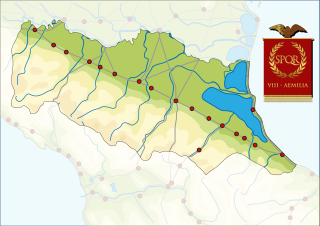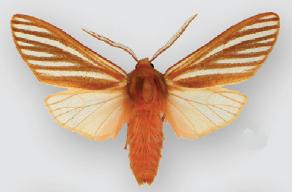
A test tube, also known as a culture tube or sample tube, is a common piece of laboratory glassware consisting of a finger-like length of glass or clear plastic tubing, open at the top and closed at the bottom.

Phlebotomy is the process of making a puncture in a vein, usually in the arm, with a cannula for the purpose of drawing blood. The procedure itself is known as a venipuncture, which is also used for intravenous therapy. A person who performs a phlebotomy is called a phlebotomist, although most doctors, nurses, and other technicians can also carry out a phlebotomy. In contrast, phlebectomy is the removal of a vein.

The Rubicon is a shallow river in northeastern Italy, just north of Rimini. It was known as Fiumicino prior to 1933, when it was identified with the ancient river Rubicon, famously crossed by Julius Caesar in 49 BC.

A Vacutainer blood collection tube is a sterile glass or plastic test tube with a colored rubber stopper creating a vacuum seal inside of the tube, facilitating the drawing of a predetermined volume of liquid. Vacutainer tubes may contain additives designed to stabilize and preserve the specimen prior to analytical testing. Tubes are available with a safety-engineered stopper, with a variety of labeling options and draw volumes. The color of the top indicates the additives in the vial.

The Via Aemilia was a trunk Roman road in the north Italian plain, running from Ariminum (Rimini), on the Adriatic coast, to Placentia (Piacenza) on the river Padus (Po). It was completed in 187 BC. The Via Aemilia connected at Rimini with the Via Flaminia to Rome, which had been completed 33 years earlier.
Aemilia is a large main-belt asteroid. Aemilia was discovered by the French brothers Paul Henry and Prosper Henry on January 26, 1876. The credit for this discovery was given to Paul. It is probably named after the Via Aemilia, a Roman road in Italy that runs from Piacenza to Rimini.
Aemilia Lepida is the name of several ancient Roman women belonging to the gens Aemilia. The name was given to daughters of men belonging to the Lepidus branch of the Aemilius family. The first Aemilia Lepida to be mentioned by Roman historians was the former fiancée of the younger Cato. Subsequent Aemiliae are known because of their marriages.

The Basilica Aemilia was a civil basilica in the Roman Forum, in Rome, Italy. Today only the plan and some rebuilt elements can be seen. The Basilica was 100 meters (328 ft) long and about 30 meters (98 ft) wide. Along the sides were two orders of 16 arches, and it was accessed through one of three entrances.

The Via Aemilia Scauri was an ancient Roman road built by the consul Marcus Aemilius Scaurus during his term as censor in 109 BC.

Aemilia Tertia, also known as Aemilia Paulla, was the wife of the Roman consul and censor Scipio Africanus. She was the daughter, possibly the third surviving daughter, of the consul Lucius Aemilius Paullus and the sister of the consul Lucius Aemilius Paullus Macedonicus.
The Basilica Fulvia was a basilica built in ancient Rome. According to Livy (40.51), the censors M. Aemilius Lepidus and M. Fulvius Nobilior had it built in 179 BC. It may be that there had been a previous building existing on the site from 210 BC which was incorporated. In 78 BC, the consul M. Aemilius Lepidus incorporated the building into the Basilica Aemilia, and it was renamed the Basilica Fulvia et Aemilia or sometimes simply the Basilica.

Aemilia is a genus of tiger moths in the family Erebidae described by William Forsell Kirby in 1892. It was initially named Ameles, but this name properly refers to a praying mantis genus.

Pseudohemihyalea is a genus of moths in the family Erebidae described by Régo Barros in 1956. While the caterpillars of most species of Pseudohemihyalea feed on broad-leaved trees, the P. ambigua group has larvae that feed on conifers. Their forewing coloration has accordingly evolved to light-and-dark lengthwise striping, giving better camouflage among the slim needles of the host plants. In this, they seem to be convergent to certain geometer moths, such as Caripeta piniata or Sabulodes niveostriata.

Aemilia ockendeni is a moth of the family Erebidae first described by Walter Rothschild in 1909. It is found in Peru and Bolivia.

Little is known of Federico di Pagana, he came from the region of Rapallo on the Genoese Riviera, so it is unclear why he was chosen as doge after Nicolò Guarco was forced out of office on April 7, 1383. But the well-introduced and astute politician Leonardo Montaldo managed to have the election canceled and to be picked instead as the new doge. After this episode, Federico di Pagana disappears from the forefront of Genoese politics.
Aemilia peropaca is a moth of the family Erebidae. It was described by Seitz in 1920. It is found in Colombia.
Aemilia rubriplaga is a moth of the family Erebidae. It was described by Francis Walker in 1855. It is found in Venezuela.
Aemilia tabaconas is a moth of the family Erebidae. It was described by James John Joicey and George Talbot in 1916. It is found in Peru.

Porticus Aemilia was a portico in ancient Rome. It was one of the largest commercial structures of its time and functioned as a storehouse and distribution center for goods entering the city via the Tiber river.
Kuning, also spelled kyuning or kiyuning and Anglicized as yellow rice or turmeric rice, is a Filipino rice dish cooked with turmeric, lemongrass, salt, bay leaves, and other spices to taste. It originates from the island of Mindanao and is a staple food among the Maranao people of Lanao del Sur. It is related to the Indonesian nasi kuning of neighboring Sulawesi, but it does not use coconut milk. The dish is characteristically yellow because of the use of turmeric.








